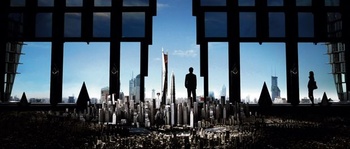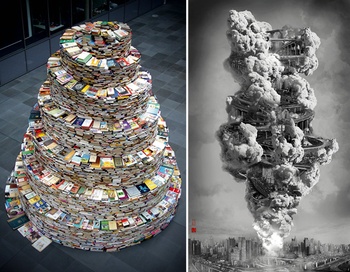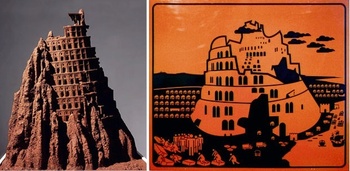(© Hendrick Dusollier)
“And the LORD said, Behold, the people is one, and they have all one language: and this they begin to do: and now nothing will be restrained from them, which they have imagined to do / Go to, let us go down, and there confound their language, that they may not understand one another’s speech.” And so it was that the Tower of Babel project failed. The power of collective human will, the megalomania mankind can be guilty of, divine chastisement, the failure of a utopia, the diversity of languages and cultures... The myth of the Tower of Babel is a rich and complex one. The Botanique is currently hosting an exhibition on the theme of this disturbing Biblical tale, which has a number of connections with a city like Brussels. Often inspired by Bruegel’s celebrated paintings, artists from different backgrounds explore various aspects of the story. We take a look at five of them.
JAKOB GAUTEL
Gautel’s huge tower takes pride of place at the centre of the exhibition. Close in form to the depiction in Bruegel’s paintings, it is made up of more than 15,000 books carefully stacked up, from Dante’s Divina Commedia to L’Anniversaire de Babar via Malraux’s Le Musée imaginaire. “The book, that emblematic object of the transmission of knowledge, is called into question by the new media and the frenetic, dazzling acceleration of the exchange of information,” explains the German artist. “The Tower of Babel, that abandoned building site, in its infinite rising spiral, never completed, is also a symbol of humanity’s need to take a break, to stop and think about what is essential, about what project to pursue, and about what is worth preserving or not.”
Babel: collapsing tower, rising art


(© Jakob Gautel & Yang Yongliang)
JOHN ISAACS
In a sculpture that mixes polystyrene, wood, balsa wood, plasticine, and sand, the English artist John Isaacs makes a connection between mankind and termites. “The Tower of Babel depicted in its unfinished state in Bruegel’s painting is one of the most complete ‘artistic’ images of human folly. I’m drawn to it as a physical symbol of what drives humanity and also what isolates us from one another. In The Architecture of Aspiration I wanted to fuse the tower with a termite mound; termites are directed by instinct to create these structures; maybe we are not so different. After all, do we really understand ourselves, each other, and what motivates us? The abandoned tower casts an organic shadow of doubt over our aspirations, and reminds us that we are ruled as much by instinct as we are by civilisation.”
YANG YONGLIANG
From afar, Yang Yongliang’s photographs and subtly animated videos seem to be very much in the tradition of Chinese landscape painting. When you get closer, however, you realise that his mountains are just clusters of tall buildings, interspersed with cranes that serve as vegetation. “The Tower of Babel was built in order to take humans up to paradise,” he recalls. “God called a halt to that absurd project by means of the very simple device of jamming their communications. Today, in the 21st century, people talk more and more all the time of globalisation: the world is becoming more unified. Even though we still have differences between languages and cultures, it has become much easier to meet and have exchanges with people in every corner of the world, thanks to developments in the fields of communications technology and means of transport. It is in the nature of human beings to try and penetrate mysteries. People have never stopped building and developing their countries. Every year we set new records for the height of buildings; we are still looking for the boundary of heaven. I made this series of works to pose the question: if God really exists, will he put a stop once again to this absurd project on the part of human beings?”
JOHN ISAACS
In a sculpture that mixes polystyrene, wood, balsa wood, plasticine, and sand, the English artist John Isaacs makes a connection between mankind and termites. “The Tower of Babel depicted in its unfinished state in Bruegel’s painting is one of the most complete ‘artistic’ images of human folly. I’m drawn to it as a physical symbol of what drives humanity and also what isolates us from one another. In The Architecture of Aspiration I wanted to fuse the tower with a termite mound; termites are directed by instinct to create these structures; maybe we are not so different. After all, do we really understand ourselves, each other, and what motivates us? The abandoned tower casts an organic shadow of doubt over our aspirations, and reminds us that we are ruled as much by instinct as we are by civilisation.”
YANG YONGLIANG
From afar, Yang Yongliang’s photographs and subtly animated videos seem to be very much in the tradition of Chinese landscape painting. When you get closer, however, you realise that his mountains are just clusters of tall buildings, interspersed with cranes that serve as vegetation. “The Tower of Babel was built in order to take humans up to paradise,” he recalls. “God called a halt to that absurd project by means of the very simple device of jamming their communications. Today, in the 21st century, people talk more and more all the time of globalisation: the world is becoming more unified. Even though we still have differences between languages and cultures, it has become much easier to meet and have exchanges with people in every corner of the world, thanks to developments in the fields of communications technology and means of transport. It is in the nature of human beings to try and penetrate mysteries. People have never stopped building and developing their countries. Every year we set new records for the height of buildings; we are still looking for the boundary of heaven. I made this series of works to pose the question: if God really exists, will he put a stop once again to this absurd project on the part of human beings?”

(© John Isaacs & Jérôme Considérant)
JÉRÔME CONSIDÉRANT
Jérôme Considérant has made a speciality of reinterpreting classic works of the history of art – Leonardo da Vinci’s Last Supper, Géricault’s Raft of the Medusa, and Botticelli’s Birth of Venus – in a visual idiom based on the pictograms used in signs. “The Tower of Babel marks the completion of one part of this artistic undertaking. It is an iconic work of art history and still remains relevant and topical. Its massive scale, in combination with such a vast number of details, is hypnotic. There is not much left to say after Bruegel... It has impact, it hits hard, it’s just right, it’s clear. I’m a fan of Bruegel. Quite simply.”
HENDRICK DUSOLLIER
If there is one country today whose staggering growth in power alarms and fascinates as much as the project undertaken by the builders of Babel, it is China. The French director Hendrick Dusollier set the story of his wordless short film Babel in Shanghai, where he takes up the duality of the lower town (where the exploited workers live) and the upper town (where the well-off wallow in a life of idleness) of Fritz Lang’s masterpiece Metropolis. “The usual interpretation is that the myth of Babel tells how human excess was crushed by God,” the film-maker observes. “And yet, a closer reading, developed by a number of writers, including Baruch in the 1st century AD, shows how the text describes and condemns totalitarianism. In it we see a whole people placing itself at the service of a tyrant, King Nimrod, to build a tower as a monument to his glory: ‘The Angel of the Lord took me and brought me to the second heaven... He showed me the plain; it was full of men with the faces of dogs and the feet of deer. And he said: these are the people who decided to construct the Tower. Those whom you see forced crowds of men and women to make bricks. If, among them, a woman was about to give birth, she was not relieved of her work: at the moment of the child’s birth, she was making bricks, and she continued to do so while carrying the child in her apron.’”
IMAGES:
JAKOB GAUTEL: La Tour de Babel, 2006-2012 © Jakob Gautel
JOHN ISAACS: © John Isaacs, Collection HeidelbergCement AG, Allemagne
YANG YONGLIANG: Heavenly City, 05, 2008 © Yang Yongliang, Galerie Paris Beijing
JÉRÔME CONSIDÉRANT: © Jérôme Considérant, Aeroplastics Contemporary, Bruxelles
HENDRICK DUSOLLIER: Babel, 2010 © Hendrick Dusollier, Studio HDK Productions
Babel • > 21/4, wo/me/We > zo/di/Su 12 > 20.00, €2,50/4,50/5,50, botanique, Koningsstraat 236 rue Royale, Sint-Joost-ten-Node/Saint-Josse-ten-Noode, 02-218.37.32, info@botanique.be, www.botanique.be
JÉRÔME CONSIDÉRANT
Jérôme Considérant has made a speciality of reinterpreting classic works of the history of art – Leonardo da Vinci’s Last Supper, Géricault’s Raft of the Medusa, and Botticelli’s Birth of Venus – in a visual idiom based on the pictograms used in signs. “The Tower of Babel marks the completion of one part of this artistic undertaking. It is an iconic work of art history and still remains relevant and topical. Its massive scale, in combination with such a vast number of details, is hypnotic. There is not much left to say after Bruegel... It has impact, it hits hard, it’s just right, it’s clear. I’m a fan of Bruegel. Quite simply.”
HENDRICK DUSOLLIER
If there is one country today whose staggering growth in power alarms and fascinates as much as the project undertaken by the builders of Babel, it is China. The French director Hendrick Dusollier set the story of his wordless short film Babel in Shanghai, where he takes up the duality of the lower town (where the exploited workers live) and the upper town (where the well-off wallow in a life of idleness) of Fritz Lang’s masterpiece Metropolis. “The usual interpretation is that the myth of Babel tells how human excess was crushed by God,” the film-maker observes. “And yet, a closer reading, developed by a number of writers, including Baruch in the 1st century AD, shows how the text describes and condemns totalitarianism. In it we see a whole people placing itself at the service of a tyrant, King Nimrod, to build a tower as a monument to his glory: ‘The Angel of the Lord took me and brought me to the second heaven... He showed me the plain; it was full of men with the faces of dogs and the feet of deer. And he said: these are the people who decided to construct the Tower. Those whom you see forced crowds of men and women to make bricks. If, among them, a woman was about to give birth, she was not relieved of her work: at the moment of the child’s birth, she was making bricks, and she continued to do so while carrying the child in her apron.’”
IMAGES:
JAKOB GAUTEL: La Tour de Babel, 2006-2012 © Jakob Gautel
JOHN ISAACS: © John Isaacs, Collection HeidelbergCement AG, Allemagne
YANG YONGLIANG: Heavenly City, 05, 2008 © Yang Yongliang, Galerie Paris Beijing
JÉRÔME CONSIDÉRANT: © Jérôme Considérant, Aeroplastics Contemporary, Bruxelles
HENDRICK DUSOLLIER: Babel, 2010 © Hendrick Dusollier, Studio HDK Productions
Babel • > 21/4, wo/me/We > zo/di/Su 12 > 20.00, €2,50/4,50/5,50, botanique, Koningsstraat 236 rue Royale, Sint-Joost-ten-Node/Saint-Josse-ten-Noode, 02-218.37.32, info@botanique.be, www.botanique.be
Read more about: Expo
Fijn dat je wil reageren. Wie reageert, gaat akkoord met onze huisregels. Hoe reageren via Disqus? Een woordje uitleg.